 |
GREEK ARCHITECTURE:GENERAL CONSIDERATIONS, THE DORIC |
| << PERSIAN, LYCIAN AND JEWISH ARCHITECTURE:Jehovah |
| GREEK ARCHITECTURE—Continued:ARCHAIC PERIOD, THE TRANSITION >> |
CHAPTER
VI.
GREEK
ARCHITECTURE.
BOOKS RECOMMENDED: As before, Reber. Also,
Anderson and Spiers,
Architecture
of
Greece
and Rome.
Baumeister, Denkmäler
der Klassischen
Alterthums.
Bötticher,
Tektonik
der Hellenen.
Chipiez, Histoire
critique des ordres grecs.
Curtius, Adler and
Treu,
Die
Ausgrabungen zu Olympia.
Durm, Antike
Baukunst (in
Handbuch
d. Arch.).
Frazer,
Pausanias'
Description of Greece.
Hitorff, L'architecture
polychrome chez
les
Grecs.
Michaelis, Der
Parthenon.
Penrose, An
Investigation, etc., of
Athenian
Architecture.
Perrot and Chipiez,
History
of Art in Primitive
Greece;
La
Grèce de
l'Epopée;
La
Grèce archaïque.
Stuart and Revett, Antiquities
of Athens.
Tarbell, History
of
Greek Art.
Texier, L'Asie
Mineure.
Wilkins, Antiquities
of Magna Græcia.
GENERAL
CONSIDERATIONS. Greek
art marks the beginning of
European
civilization.
The Hellenic race gathered up
influences and suggestions from both
Asia
and
Africa and fused them with others,
whose sources are unknown, into an
art
intensely
national and original, which was to
influence the arts of many races
and
nations
long centuries after the
decay of the Hellenic states. The
Greek mind,
compared
with the Egyptian or Assyrian, was
more highly intellectual, more
logical,
more
symmetrical, and above all more
inquiring and analytic. Living
nowhere remote
from
the sea, the Greeks became
sailors, merchants, and colonizers. The
Ionian
kinsmen
of the European Greeks, speaking a
dialect of the same language,
populated
the
coasts of Asia Minor and many of the
islands, so that through them the
Greeks
were
open to the influences of the Assyrian,
Phoenician, Persian, and
Lycian
civilizations.
In Cyprus they encountered Egyptian
influences, and finally, under
Psammetichus,
they established in Egypt itself the
Greek city of Naukratis. They
were
thus by geographical situation, by
character, and by circumstances,
peculiarly
fitted
to receive, develop, and transmit the
mingled influences of the East and
the
South.
Olympiad,
776 B.C. The earliest monuments of that
historic architecture which
developed
into the masterpieces of the Periclean and
Alexandrian ages, date from
the
middle
of the following century. But there are a
number of older buildings,
belonging
presumably
to the so-called Heroic Age, which,
though seemingly unconnected with
the
later historic development of
Greek architecture, are
still worthy of note. They
are
the work of a people somewhat advanced in
civilization, probably the
Pelasgi,
who
preceded the Dorians on Greek
soil, and consist mainly of
fortifications, walls,
gates,
and tombs, the most important of which
are at Mycenæ
and
Tiryns. At
the
latter
place is a well-defined acropolis, with
massive walls in which are
passages
covered
by stones successively overhanging or
corbelled until they meet. The
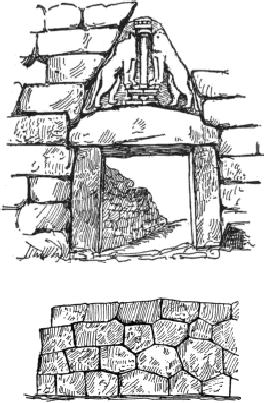
masonry
is of huge stones piled without
cement. At Mycenæ the city wall is
pierced
by
the remarkable Lion
Gate (Fig.
22), consisting of two jambs and a huge
lintel,
over
which the weight is relieved by a
triangular opening. This is
filled with a
sculptured
group, now much defaced, representing two
rampant lions flanking
a
singular
column which tapers downward. This
symbolic group has relations
with
Hittite
and Phrygian sculptures, and with the
symbolism of the worship of
Rhea
Cybele.
The masonry of the wall is carefully
dressed but not regularly coursed.
Other
primitive
walls and gates showing
openings and embryonic arches of
various forms,
are
found widely scattered, at Samos and
Delos, at Phigaleia, Thoricus,
Argos and
many
other points.
FIG.
22.--LION GATE AT MYCENÆ.
FIG.
23.--POLYGONAL MASONRY.
The
very earliest are hardly more than
random piles of rough stone.
Those which
may
fairly claim notice for their artistic
masonry are of a later date
and of two kinds:
the
coursed, and the polygonal or Cyclopean,
so called from the tradition that
they
were
built by the Cyclopes. These Cyclopean
walls were composed of
large, irregular
polygonal
blocks carefully fitted
together and dressed to a fairly smooth
face (Fig.
23).
Both kinds were used
contemporaneously, though in the course of
time the
regular
coursed masonry finally superseded the
polygonal.
THOLOS
OF ATREUS. All
these structures present,
however, only the rudiments of
architectural
art. The so-called Tholos
(or
Treasury) of Atreus, at
Mycenæ, on the
other
hand, shows the germs of truly artistic
design (Fig. 24). It is in reality a
tomb,
and
is one of a large class of
prehistoric tombs found in almost
every part of the
globe,
consisting of a circular stone-walled and
stone-roofed chamber buried under
a
tumulus
of earth. This one is a
beehive-shaped construction of horizontal
courses of
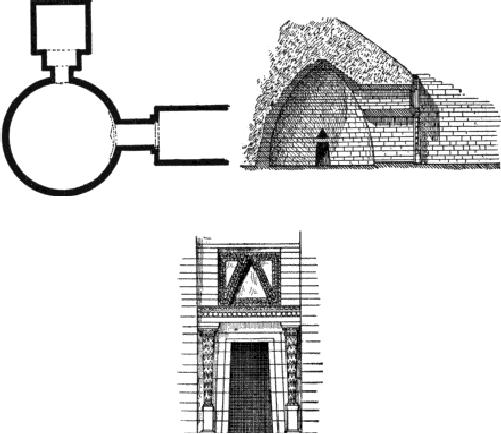
masonry,
with a stone-walled passage, the
dromos,
leading to the entrance
door.
Though
internally of domical form, its
construction with horizontal beds in
the
masonry
proves that the idea of the true dome
with the beds of each course
pitched
at
an angle always normal to the
curve of the vault, was not yet grasped.
A small
sepulchral
chamber opens from the great
one, by a door with the customary
relieving
triangle
over it.
FIG.
24.--THOLOS OF ATREUS. PLAN AND
SECTION.
FIG.
25.--THOLOS OF ATREUS. DOORWAY.
Traces
of a metal lining have been
found on the inner surface of the dome and on
the
jambs
of the entrance door. This
entrance is the most artistic and
elaborate part of
the
edifice (Fig. 25). The main opening is
enclosed in a three-banded frame, and
was
once
flanked by columns which, as shown by
fragments still existing and by
marks
on
either side the door,
tapered downward as in the sculptured column
over the Lion
Gate.
Shafts, bases, and capitals
were covered with zig-zag
bands or chevrons of
fine
spirals.
This well-studied decoration, the
banded jambs, and the curiously
inverted
columns
(of which several other
examples exist in or near
Mycenæ), all point to a
fairly
developed art, derived partly from
Egyptian and partly from Asiatic
sources.
That
Egyptian influences had affected this
early art is further proved by a
fragment
of
carved and painted ornament on a
ceiling in Orchomenos, imitating
with
remarkable
closeness certain ceiling
decorations in Egyptian
tombs.
HISTORIC
MONUMENTS; THE ORDERS. It
was the Dorians and Ionians
who
developed
the architecture of classic Greece.
This fact is perpetuated in
the
traditional
names, Doric and Ionic,
given to the two systems of columnar
design
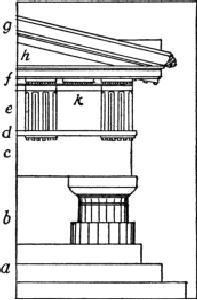
which
formed the most striking
feature of that architecture. While in
Egypt the
column
was used almost exclusively
as an internal support and decoration, in
Greece
it
was chiefly employed to
produce an imposing exterior
effect. It was the
most
important
element in the temple architecture of the
Greeks, and an almost
indispensable
adornment of their gateways,
public squares, and temple
enclosures.
To
the column the two races named above
gave each a special and
radically distinct
development,
and it was not until the Periclean age that the two
forms came to be
used
in conjunction, even by the mixed
Doric-Ionic people of Attica.
Each of the two
types
had its own special shaft,
capital, entablature, mouldings, and
ornaments,
although
considerable variation was
allowed in the proportions and minor
details.
The
general type, however,
remained substantially unchanged from
first to last. The
earliest
examples known to us of either order show
it complete in all its parts,
its
later
development being restricted to the
refining and perfecting of its
proportions
and
details. The probable origin of
these orders will be separately
considered
later
on.
FIG.
26.--GREEK DORIC
ORDER.
A,
Crepidoma, or stylobate; b, Column; c,
Architrave; d, Tænia; e, Frieze; f,
Horizontal
cornice;
g, Raking cornice; h, Tympanum of
pediment; k, Metope.
THE
DORIC. The column of
the Doric order (Figs. 26, 27)
consists of a tapering
shaft
rising directly from the stylobate or
platform and surmounted by a capital
of
great
simplicity and beauty. The shaft is
fluted with sixteen to twenty
shallow
channellings
of segmental or elliptical section,
meeting in sharp edges or
arrises.
The
capital
is made up of a circular cushion or
echinus
adorned
with fine grooves
called
annulæ, and a
plain square abacus
or
cap Upon this rests a plain
architrave or
epistyle, with a
narrow fillet, the tænia, running
along its upper edge. The
frieze
above
it is divided into square panels,
called the metopes,
separated by vertical
triglyphs
having
each two vertical grooves and
chamfered edges. There is a
triglyph
over
each column and one over
each intercolumniation, or two in rare
instances
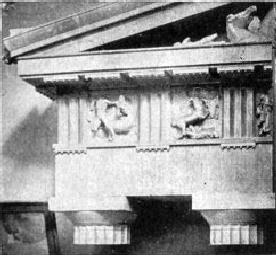
where
the columns are widely spaced. The
cornice consists of a broadly
projecting
corona
resting
on a bed-mould
of
one or two simple mouldings. Its under
surface,
called
the soffit, is
adorned with mutules,
square, flat projections having
each
eighteen
guttæ
depending
from its under side. Two or three
small mouldings run
along
the upper edge of the corona, which
has in addition, over each
slope of the
gable,
a gutter-moulding or cymatium. The
cornices along the horizontal
edges of the
roof
have instead of the cymatium a row of
antefixæ,
ornaments of terra-cotta or
marble
placed opposite the foot of
each tile-ridge of the roofing. The
enclosed
triangular
field of the gable, called the
tympanum,
was in the larger
monuments
adorned
with sculptured groups resting on the
shelf formed by the horizontal
cornice
below.
Carved ornaments called
acroteria
commonly
embellished the three angles
of
the
gable or pediment.
POLYCHROMY.
It
has been fully proved, after
a century of debate, that all this
elaborate
system of parts, severe and
dignified in their simplicity of form,
received a
rich
decoration of color. While the
precise shades and tones
employed cannot be
predicated
with certainty, it is well established that the
triglyphs were painted
blue
and
the metopes red, and that all the
mouldings were decorated with
leaf-ornaments,
"eggs-and-darts,"
and frets, in red, green,
blue, and gold. The walls and
columns
were
also colored, probably with
pale tints of yellow or buff, to reduce the
glare of
the
fresh marble or the whiteness of the
fine stucco with which the surfaces
of
masonry
of coarser stone were
primed. In the clear Greek
atmosphere and outlined
against
the brilliant sky, the Greek temple must
have presented an aspect of
rich,
sparkling
gayety.
FIG.
27.--DORIC ORDER OF THE
PARTHENON.
ORIGIN
OF THE ORDER. It is
generally believed that the details of
the Doric frieze
and
cornice were reminiscences of a
primitive wood construction. The
triglyph
suggests
the chamfered ends of cross-beams
made up of three planks
each; the
mutules,
the sheathing of the eaves; and the
guttæ, the heads of the spikes
or
trenails
by which the sheathing was secured. It is
known that in early astylar
temples
the
metopes were left open like
the spaces between the ends of
ceiling-rafters. In the
earlier
peripteral temples, as at Selinus, the
triglyph-frieze is retained around
the
cella-wall
under the ceiling of the colonnade, where
it has no functional
significance,
as
a survival from times antedating the
adoption of the colonnade, when the
tradition
of
a wooden roof-construction showing
externally had not yet been
forgotten.
A
similar wooden origin for the
Doric column has been
advocated by some, who
point
to the assertion of Pausanias that in the
Doric Heraion at Olympia the
original
wooden
columns had with one exception
been replaced by stone
columns as fast as
they
decayed. This, however, only
proves that wooden columns
were sometimes used
in
early buildings, not that the Doric
column was derived from them. Others
would
derive
it from the Egyptian columns of Beni
Hassan, which it certainly resembles.
But
they
do not explain how the Greeks could
have been familiar with the
Beni Hassan
column
long before the opening of
Egypt to them under Psammetichus; nor
why,
granting
them some knowledge of Egyptian
architecture, they should have
passed
over
the splendors of Karnak and Luxor to copy
these inconspicuous tombs
perched
high
up on the cliffs of the Nile. It would
seem that the Greeks invented this
form
independently,
developing it in buildings which have
perished; unless, indeed,
they
brought
the idea with them from their primitive Aryan
home in Asia.
THE
IONIC ORDER was
characterized by greater slenderness of
proportion and
elegance
of detail than the Doric, and depended
more on carving than on color
for
the
decoration of its members
(Fig. 28). It was adopted in the fifth
century B.C. by
the
people of Attica, and used both for
civic and religious buildings,
sometimes alone
and
sometimes in conjunction with the Doric.
The column was from eight to ten
diameters
in height, against four and one-third to
seven for the Doric. It stood on
a
base
which was usually composed of two tori
separated by a scotia
(a
concave
moulding
of semicircular or semi-elliptical
profile), and was sometimes
provided also
with
a square flat base-block, the plinth.
There was much variety in the
proportions
and
details of these mouldings, which
were often enriched by
flutings or carved
guilloches.
The tall shaft bore twenty-four deep
narrow flutings separated by
narrow
fillets.
The capital was the most
peculiar feature of the order. It
consisted of a bead
or
astragal
and
echinus, over which was a
horizontal band ending on
either side in a
scroll
or volute, the sides of which presented
the aspect shown in Fig. 29. A
thin
moulded
abacus was interposed
between this member and the
architrave.
The
Ionic capital was marked by two awkward
features which all its richness
could
not
conceal. One was the protrusion of the
echinus beyond the face of the
band
above
it, the other was the disparity
between the side and front views of the
capital,
especially
noticeable at the corners of a colonnade.
To obviate this,
various
contrivances
were tried, none wholly
successful. Ordinarily the two adjacent
exterior
sides
of the corner capital were
treated alike, the scrolls at their
meeting being bent
out
at an angle of 45°, while the two inner faces
simply intersected, cutting
each
other
in halves.

FIG.
28.--GREEK IONIC ORDER.
(MILETUS.)
The
entablature comprised an architrave of
two or three flat bands crowned by
fine
mouldings;
an uninterrupted frieze, frequently
sculptured in relief; and a
simple
cornice
of great beauty. In addition to the
ordinary bed-mouldings there
was in most
examples
a row of narrow blocks or dentils
under the
corona, which was
itself
crowned
by a high cymatium of extremely graceful
profile, carved with the rich
"honeysuckle"
(anthemion)
ornament. All the mouldings were
carved with the "egg-
and-dart,"
heart-leaf and anthemion ornaments, so
designed as to recall by their
outline
the profile of the moulding itself. The
details of this order were
treated with
much
more freedom and variety than
those of the Doric. The pediments of
Ionic
buildings
were rarely or never adorned
with groups of sculpture. The volutes
and
echinus
of the capital, the fluting of the shaft, the
use of a moulded circular
base,
and
in the cornice the high corona and
cymatium, these were
constant elements in
every
Ionic order, but all other details
varied widely in the different
examples.
FIG.
29.--SIDE VIEW OF IONIC
CAPITAL.
ORIGIN
OF THE IONIC ORDER. The
origin of the Ionic order has
given rise to
almost
as much controversy as that of the Doric. Its
different elements
were
apparently
derived from various sources. The
Lycian tombs may have
contributed the
denticular
cornice and perhaps also the
general form of the column and capital.
In
the
Persian architecture of the sixth
century B.C., the high moulded
base, the narrow
flutings
of the shaft, the carved bead-moulding
and the use of scrolls in the
capital
are
characteristic features, which may have
been borrowed by the Ionians
during the
same
century, unless, indeed, they were
themselves the work of Ionic or
Lycian
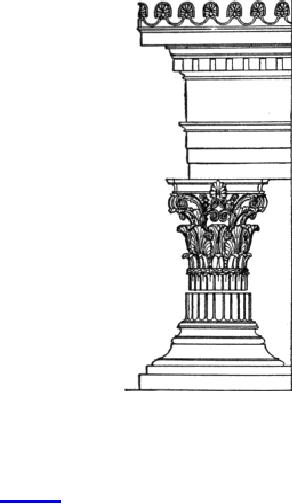
workmen
in Persian employ. The banded
architrave and the use of the volute in
the
decoration
of stele-caps (from στηλη
=
a memorial stone or column standing
isolated
and
upright), furniture, and minor structures
are common features in
Assyrian,
Lycian,
and other Asiatic architecture of
early date. The volute or
scroll itself as an
independent
decorative motive may have
originated in successive variations
of
development
into the final form of the order was the work of the
Ionian Greeks, and
it
was in the Ionian provinces of Asia Minor
that the most splendid examples of
its
use
are to be found (Halicarnassus, Miletus,
Priene, Ephesus), while the
most
graceful
and perfect are those of
Doric-Ionic Attica.
FIG.
30.--GREEK CORINTHIAN
ORDER.
(From
the monument of
Lysicrates.)
THE
CORINTHIAN ORDER. This
was a late outgrowth of the Ionic rather
than a
new
order, and up to the time of the Roman
conquest was only used for
monuments
of
small size (see Fig.
38).
Its entablature in pure Greek
examples was identical
with
the
Ionic; the shaft and base were only
slightly changed in proportion and
detail. The
capital,
however, was a new departure,
based probably on metallic
embellishments of
altars,
pedestals, etc., of Ionic style. It
consisted in the best examples of a high
bell-
shaped
core surrounded by one or two
rows of acanthus leaves,
above which were
pairs
of branching scrolls meeting at the
corners in spiral volutes.
These served to
support
the angles of a moulded abacus with
concave sides (Fig. 30). One
example,
from
the Tower of the Winds (the clepsydra of
Andronicus Cyrrhestes) at Athens,
has
only
smooth pointed palm-leaves and no
scrolls above a single row of
acanthus
leaves.
Indeed, the variety and disparity
among the different examples
prove that we
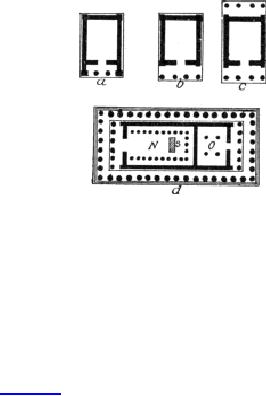
have
here only the first steps
toward the evolution of an independent
order, which it
was
reserved for the Romans to fully
develop.
GREEK
TEMPLES; THE TYPE. With the
orders as their chief
decorative element the
Greeks
built up a splendid architecture of
religious and secular monuments.
Their
noblest
works were temples, which they
designed with the utmost simplicity
of
general
scheme, but carried out with a mastery of
proportion and detail which
has
never
been surpassed. Of moderate
size in most cases, they
were intended
primarily
to
enshrine the simulacrum of the deity, and not,
like Christian churches,
to
accommodate
great throngs of worshippers. Nor
were they, on the other hand,
sanctuaries
designed, like those of
Egypt, to exclude all but a privileged
few from
secret
rites performed only by the priests and
king. The statue of the deity
was
enshrined
in a chamber, the naos
(see
plan, Fig. 31), often of
considerable size, and
accessible
to the public through a columnar porch
the pronaos. A
smaller chamber,
the
opisthodomus,
was sometimes added in the
rear of the main sanctuary, to
serve
as
a treasury or depository for votive
offerings. Together these
formed a windowless
structure
called the cella,
beyond which was the rear
porch, the posticum
or
epinaos.
This
whole structure was in the larger
temples surrounded by a colonnade,
the
peristyle, which
formed the most splendid
feature of Greek architecture. The
external
aisle
on either side of the cella
was called the pteroma. A
single gabled roof
covered
the
entire building.
FIG.
31.--TYPES OF GREEK TEMPLE
PLANS.
a,
In Antis; b, Prostyle; c, Amphiprostyle;
d, Peripteral (The Parthenon); N,
Naos; O,
Opisthodomus;
S, Statue.
The
Greek colonnade was thus an
exterior feature, surrounding the
solid cella-wall
instead
of being enclosed by it as in Egypt. The
temple was a public, not a
royal
monument;
and its builders aimed, not as in
Egypt at size and overwhelming
sombre
majesty,
but rather at sunny beauty and the
highest perfection of
proportion,
There
were of course many variations of the
general type just described. Each
of
these
has received a special name,
which is given below with explanations
and is
illustrated
in Fig. 31.

In
antis; with a
porch having two or more
columns enclosed between the
projecting
side-walls
of the cella.
Prostylar
(or
prostyle); with a columnar porch in front
and no peristyle.
Amphiprostylar
(or
-style); with columnar porches at both
ends but no peristyle.
Peripteral;
surrounded by columns.
Pseudoperipteral; with
false or engaged columns built into the
walls of the cella,
leaving
no pteroma.
Dipteral; with
double lateral ranges of
columns (see Fig.
39).
Pseudodipteral; with a
single row of columns on each
side, whose distance from
the
wall
is equal to two intercolumniations of the
front.
Tetrastyle,
hexastyle,
octastyle,
decastyle,
etc.; with four, six, eight, or ten
columns in
the
end rows.
CONSTRUCTION.
All the
temples known to us are of stone, though
it is evident
from
allusions in the ancient writers that
wood was sometimes used in
early times.
The
finest temples, especially
those of Attica, Olympia, and
Asia Minor, were of
marble.
In Magna Græcia, at Assos, and in
other places where marble
was wanting,
limestone,
sandstone, or lava was
employed and finished with a thin, fine
stucco.
The
roof was almost invariably
of wood and gabled, forming at the
ends pediments
decorated
in most cases with sculpture. The
disappearance of these inflammable
and
perishable
roofs has given rise to
endless speculations as to the lighting
of the cellas,
which
in all known ruins, except one at
Agrigentum, are destitute of
windows. It has
been
conjectured that light was admitted
through openings in the roof, and even
that
the
central part of the cella was wholly
open to the sky. Such an arrangement
is
termed
hypæthral, from an
expression used in a description by
Vitruvius;9
but
this
description
corresponds to no known structure, and the
weight of opinion now
inclines
against the use of the hypæthral
opening, except possibly in
one or two of
the
largest temples, in which a part of the
cella in front of the statue may have
been
thus
left open. But even this partial
hypæthros
is not
substantiated by direct
evidence.
It hardly seems probable that the
magnificent chryselephantine statues
of
such
temples were ever thus left
exposed to the extremes of the climate,
which are
often
severe even in Greece. In the
model of the Parthenon designed by Ch.
Chipiez
for
the Metropolitan Museum in New York, a small
clerestory opening through the
roof
admits a moderate amount of light to the
cella; but this ingenious device
rests
on
no positive evidence (see Frontispiece).
It seems on the whole most
probable that
the
cella was lighted entirely
by artificial illumination; but the
controversy in its
present
state is and must be wholly
speculative.
The
wooden roof was covered with
tiles of terra-cotta or marble. It
was probably
ceiled
and panelled on the under side, and richly
decorated with color and gold.
The
pteroma
had under the exterior roof a ceiling of
stone or marble, deeply
panelled
between
transverse architraves.
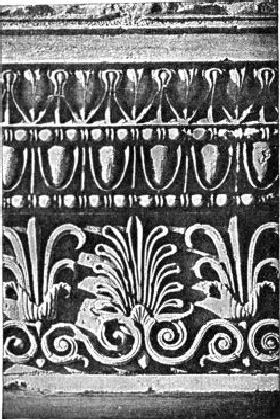
The
naos and opisthodomus being in the
larger temples too wide to
be spanned by
single
beams, were furnished with
interior columns to afford
intermediate support.
To
avoid the extremes of too
great massiveness and excessive
slenderness in these
columns,
they were built in two stages, and
advantage was taken of
this
arrangement,
in some cases, at least, to
introduce lateral galleries into the
naos.
FIG.
32.--CARVED ANTHEMION ORNAMENT.
ATHENS.
SCULPTURE
AND CARVING. All the
architectural membering was
treated with the
greatest
refinement of design and execution, and
the aid of sculpture, both in
relief
and
in the round, was invoked to give
splendor and significance to the
monument.
The
statue of the deity was the
focus of internal interest, while
externally, groups of
statues
representing the Olympian deities or the
mythical exploits of gods,
demigods,
and
heroes, adorned the gables.
Relief carvings in the friezes and
metopes
commemorated
the favorite national myths. In these
sculptures we have the
finest
known
adaptations of pure sculpture--i.e.,
sculpture treated as such and
complete in
itself--to
an architectural framework. The noblest
examples of this decorative
sculpture
are those of the Parthenon,
consisting of figures in the full round from
the
pediments,
groups in high relief from the metopes,
and the beautiful frieze of the
Panathenaic
procession from the cella-wall under the
pteroma ceiling. The
greater
part
of these splendid works are
now in the British Museum, whither they
were
removed
by Lord Elgin in 1801. From
Olympia, Ægina, and Phigaleia,
other master-
works
of the same kind have been
transferred to the museums of Europe. In
the
Doric
style there was little
carving other than the sculpture, the
ornament being
mainly
polychromatic. Greek Ionic and Corinthian
monuments, however, as well as
minor
works such as steles,
altars, etc., were richly
adorned with carved
mouldings
and
friezes, festoons, acroteria, and
other embellishments executed with the
chisel.
The
anthemion ornament, a form related to the
Egyptian lotus and
Assyrian
palmette,
most frequently figures in
these. It was made into
designs of wonderful
vigor
and beauty (Fig. 32).
DETAIL
AND EXECUTION. In the
handling and cutting of stone the
Greeks
displayed
a surpassing skill and delicacy.
While ordinarily they were
content to use
stones
of moderate size, they never
hesitated at any dimension necessary for
proper
effect
or solid construction. The lower drums of
the Parthenon peristyle are 6
feet
6½
inches in diameter, and 2 feet 10
inches high, cut from single
blocks of Pentelic
marble.
The architraves of the Propylæa at Athens
are each made up of two
lintels
placed
side by side, the longest 17
feet 7 inches long, 3 feet
10 inches high, and
2
feet 4 inches thick. In the colossal
temples of Asia Minor, where the
taste for the
vast
and grandiose was more
pronounced, blocks of much greater
size were used.
These
enormous stones were cut and
fitted with the most scrupulous
exactness. The
walls
of all important structures were built in
regular courses throughout,
every stone
carefully
bedded with extremely close
joints. The masonry was
usually laid up
without
cement and clamped with metal;
there is no filling in with rubble
and
concrete
between mere facings of cut
stone, as in most modern work. When the
only
available
stone was of coarse texture
it was finished with a coating of
fine stucco, in
which
sharp edges and minute detail
could be worked.
The
details were, in the best
period, executed with the most
extraordinary refinement
and
care. The profiles of capitals and
mouldings, the carved ornament, the
arrises of
the
flutings, were cut with marvellous
precision and delicacy. It has
been rightly said
that
the Greeks "built like Titans and
finished like jewellers." But this
perfect finish
was
never petty nor wasted on unworthy or
vulgar design. The just relation of
scale
between
the building and all its parts
was admirably maintained; the
ornament was
distributed
with rare judgment, and the vigor of
its design saved it from
all
appearance
of triviality.
The
sensitive taste of the Greeks
led them into other refinements than
those of mere
mechanical
perfection. In the Parthenon especially,
but also in lesser degree in
other
temples,
the seemingly straight lines of the
building were all slightly
curved, and the
vertical
faces inclined. This was
done to correct the monotony and
stiffness of
absolutely
straight lines and right angles, and
certain optical illusions which
their
acute
observation had detected. The long
horizontal lines of the stylobate and
cornice
were
made convex upward; a similar
convexity in the horizontal corona of
the
pediment
counteracted the seeming concavity
otherwise resulting from its
meeting
with
the multiplied inclined lines of the
raking cornice. The columns
were almost
imperceptibly
inclined toward the cella, and the
corner intercolumniations made
a
trifle
narrower than the rest; while the
vertical lines of the arrises of the
flutings were
made
convex outward with a curve of the utmost
beauty and delicacy. By these
and
other
like refinements there was
imparted to the monument an elasticity and
vigor of

aspect,
an elusive and surprising beauty
impossible to describe and not to
be
explained
by the mere composition and general
proportions, yet manifest to
every
cultivated
eye.10
7.
For
enlargement on this topic
see Appendix
A.
8.
As
contended by W. H. Goodyear in his
Grammar
of the Lotus.
9.
Lib.
III., Cap. I.
10.
These
refinements, first noticed by
Allason in 1814, and later
confirmed by
Cockerell
and Haller as to the
columns, were published to
the world in 1838 by
Hoffer,
verified by Penrose in 1846, and
further developed by the
investigations of
Ziller
and later observers.
Table of Contents:
- PRIMITIVE AND PREHISTORIC ARCHITECTURE:EARLY BEGINNINGS
- EGYPTIAN ARCHITECTURE:LAND AND PEOPLE, THE MIDDLE EMPIRE
- EGYPTIAN ARCHITECTURE—Continued:TEMPLES, CAPITALS
- CHALDÆAN AND ASSYRIAN ARCHITECTURE:ORNAMENT, MONUMENTS
- PERSIAN, LYCIAN AND JEWISH ARCHITECTURE:Jehovah
- GREEK ARCHITECTURE:GENERAL CONSIDERATIONS, THE DORIC
- GREEK ARCHITECTURE—Continued:ARCHAIC PERIOD, THE TRANSITION
- ROMAN ARCHITECTURE:LAND AND PEOPLE, GREEK INFLUENCE
- ROMAN ARCHITECTURE—Continued:IMPERIAL ARCHITECTURE
- EARLY CHRISTIAN ARCHITECTURE:INTRODUCTORY, RAVENNA
- BYZANTINE ARCHITECTURE:DOMES, DECORATION, CARVED DETAILS
- SASSANIAN AND MOHAMMEDAN ARCHITECTURE:ARABIC ARCHITECTURE
- EARLY MEDIÆVAL ARCHITECTURE:LOMBARD STYLE, FLORENCE
- EARLY MEDIÆVAL ARCHITECTURE.—Continued:EARLY CHURCHES, GREAT BRITAIN
- GOTHIC ARCHITECTURE:STRUCTURAL PRINCIPLES, RIBBED VAULTING
- GOTHIC ARCHITECTURE IN FRANCE:STRUCTURAL DEVELOPMENT
- GOTHIC ARCHITECTURE IN GREAT BRITAIN:GENERAL CHARACTER
- GOTHIC ARCHITECTURE IN GERMANY, THE NETHERLANDS, AND SPAIN
- GOTHIC ARCHITECTURE IN ITALY:CLIMATE AND TRADITION, EARLY BUILDINGS.
- EARLY RENAISSANCE ARCHITECTURE IN ITALY:THE CLASSIC REVIVAL, PERIODS
- RENAISSANCE ARCHITECTURE IN ITALY—Continued:BRAMANTE’S WORKS
- RENAISSANCE ARCHITECTURE IN FRANCE:THE TRANSITION, CHURCHES
- RENAISSANCE ARCHITECTURE IN GREAT BRITAIN AND THE NETHERLANDS
- RENAISSANCE ARCHITECTURE IN GERMANY, SPAIN, AND PORTUGAL
- THE CLASSIC REVIVALS IN EUROPE:THE EIGHTEENTH CENTURY
- RECENT ARCHITECTURE IN EUROPE:MODERN CONDITIONS, FRANCE
- ARCHITECTURE IN THE UNITED STATES:GENERAL REMARKS, DWELLINGS
- ORIENTAL ARCHITECTURE:INTRODUCTORY NOTE, CHINESE ARCHITECTURE
- APPENDIX.